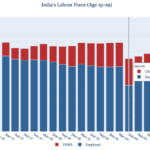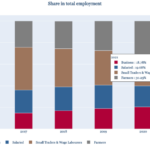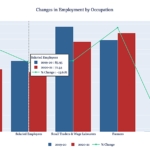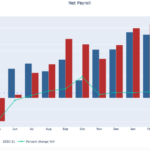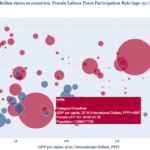CEDA-CMIE: India’s shrinking female workforce
Key findings:
- National average monthly employment (male) in 2021 was 1.3 percent less than 2019 (pre-pandemic).
- National average monthly employment (female) in 2021 was 6.4 percent lower than 2019.
- Sharp decline in average monthly employment (urban female) in the country. 22.1 percent fewer women employed in urban India in 2021 as compared to 2019.
- Decline in male employment in a quarter sees a comparable increase in number of men actively looking for jobs. Similar trend not seen among women.
- Not only are fewer women employed in India, but we also find fewer women actively looking for jobs in 2021 as compared to both 2019 and 2020. Decline is sharp in both rural and urban India but sharper in the latter.
- Four states saw more than 50 percent decline in average monthly female employment in 2021, compared to 2019.
CEDA-CMIE Bulletins have tracked changes in employment since 2021. While the first CEDA-CMIE Bulletin looked at employment in 2020, in subsequent bulletins we presented long-term view on employment in India and also monthly changes in employment by gender, sector, occupation etc. In this CEDA-CMIE Bulletin we dive into state-wise changes in employment by gender between January 2019 till September 2021. This is based on CMIE’s state-wise monthly time-series of employment that goes back to January 2019 even as its India time-series goes back to January 2016.
Figure 1 shows quarterly changes in average employment by gender across India from Q1 (Jan-March) – 2016 to Q4 (Oct-Dec) – 2021. For example, Q2 – 2020 (Apr-Jun 2020) had an average monthly employment of 291.5 million for males and 32.8 million for females. These were 69.5 million less for males and 10.3 million less for females when compared to average monthly employment in the preceding quarter (Q1 – 2020). We are aware that Q2 – 2020 was the quarter when national lockdown was imposed across the country owing to the Covid-19 pandemic. The following quarter (Q3 – 2020) saw 61.1 million increase in average monthly employment for men and a rise of 8.8 million for women.
A similar trend is seen in Q2 and Q3, 2021. While average monthly employment for men declined by 12 million in Q2 (over Q1), it increased by 13.5 million in Q3 (over Q2). The decline in average employment in Q2 – 2021 can also be attributed to the second wave of the Covid-19 pandemic in the country in the same period.
Figure 1
Figure 2 shows quarterly changes in number of unemployed, willing to work, and actively looking for job (UEWL) males and females across India. While in Figure 1 we saw that Q2 – 2020 saw a sharp decline in employment numbers (decline of 69.5 million for men and 10.3 million for women), the number of men actively looking for jobs swelled by 36.5 million in the same quarter. However, a similar increase was not observed for women whose UEWL numbers increased by only 0.8 million in Q2 – 2020. Thus, while fewer men and women were employed in Q2 – 2020, more men were actively looking for jobs than women.
Figure 2
Only looking at quarterly changes in employment numbers for men and women hides longer-term changes. Figure 3a shows us state-wise average monthly employment in calendar years 2019, 2020, and 2021 for males. While 2019 predates the Covid-19 pandemic, 2020 saw the onset of the pandemic, followed by imposition of nationwide lockdowns and local movement restrictions. The year 2021 also saw the pandemic affect the economy even though it did not have national lockdowns.
Figure 3a
To find a state’s average monthly employment (for males) in 2019, 2020, and 2021, hover over the state to find the number in millions.
When we compare average monthly employment in 2021 with 2019, we can observe how average employment has changed from pre-Covid to Covid period while comparisons between 2021 and 2020 can show us how the employment (and therefore the economy) has progressed sequentially.
The average monthly employment for males in the country in 2019, 2020, and 2021 was 359.64 mn, 340.11 mn, and 355.06 mn respectively. Thus in 2021, the average monthly employment was up by 4.4 percent over the previous year. But when we compare 2021 with the pre-pandemic year 2019, we find that India’s average monthly employment for males has declined by 1.3 percent.
Among larger Indian states, the highest increase in employment for males in 2021 (over 2020) is seen in Jharkhand at 12.3 percent (up from 8.75 million to 9.83 million). In fact, Jharkhand’s average monthly employment in 2021 is higher than in 2019 (by 4.3 percent). Similarly, average monthly male employment in Gujarat in the year 2021 was up 10.2 percent over 2020, and by 4.4 percent over 2019.
However, in Tamil Nadu and NCT of Delhi, the average monthly male employment in 2021 is still significantly lower than average monthly employment in 2019. While Tamil Nadu has seen a decline of 11.2 percent (2021 vs 2019), Delhi has seen a decline of 12.5 percent. Similarly, the states of Kerala (-8.6 percent), Haryana (-5.4 percent), and Andhra Pradesh (-5 percent) had fewer males employed in 2021 than in 2019.
We do not observe a significant difference in these patterns across urban and rural areas. For urban India, average monthly employment in 2021 was 5.3 percent more than 2020 but 1.9 percent less than 2019. For rural India, average monthly employment in 2021 was 4 percent more than 2020 but 1 percent less than 2019.
Figure 3b shows us state-wise average monthly employment for women in the years 2019, 2020, and 2021. The average monthly female employment in India in 2019 was 43.5 mn, which decreased t0 38.83 mn in 2020 and increased to 40.73 mn in 2021.
Figure 3b
To find a state’s average monthly employment (for females) in 2019, 2020, and 2021, hover over the state to find the number in millions.
India’s average monthly female employment in 2021 is 4.9 percent more than 2020 but 6.4 percent less than 2019. Thus, while male employment in 2021 was only 1.3 percent less than 2019, female employment continues to be significantly lower.
Unlike male employment, we also see an urban-rural divide when it comes to female employment in the country. Average female employment in urban India in 2021 is 6.9 percent lower than 2020 and 22.1 percent lower than the pre-pandemic year, 2019. In rural India however, female employment in 2021 was 9.2 percent higher than 2020 and only 0.1 percent lower than 2019. Therefore, we can see that female employment has suffered a significant reversal in urban India since the pandemic struck the country.
Four states had more than 50 percent decline in average monthly female employment in 2021, compared to 2019. These were Tamil Nadu (-50.9 percent), Goa (-56 percent), Jammu and Kashmir (-61 percent), and Punjab (-57.9 percent).
When we look at different regions, we observe that except Jharkhand, all eastern Indian states (West Bengal, Odisha, and Chhattisgarh) registered a significant increase in female employment in 2021 over 2020.
This reversal of female employment in urban India is also reflected in the number of women actively looking for jobs. Figure 4a and 4b show us the average monthly state-wise UEWL numbers for men and women respectively in the years 2019, 2020, and 2021.
Figure 4a
Figure 4b
As noted earlier, CMIE data shows that urban India had 22.1 percent fewer women employed in 2021 as compared to 2019. UEWL data shows that fewer women were actively looking for jobs in 2021. While 9.52 million women actively searched for jobs every month in 2019, this number declined to 8.32 million in 2020 and only 6.52 million in 2021. This trend was observed in both urban and rural India.
In urban India, only 2.57 million women actively searched for jobs every month in 2021 as compared to 3.87 million in 2019 (a decline of 33.7 percent). In rural India, only 3.95 million women actively looked for jobs in 2021 as compared to 5.16 million in 2020 and 2021 (23.5 percent less).
Thus, we can say that since the onset of the Covid-19 pandemic, not only are fewer women employed in India, but even fewer women are looking for jobs. We don’t observe this trend in the male workforce. The number of male workers actively looking for jobs in 2021 is up by 19.7 percent in urban India and 14.9 percent in rural India (compared to 2019).
Concluding Comments
The devastating effect of the Covid-19 pandemic on the Indian economy is now widely acknowledged. From sharp drop in GDP growth, rise in unemployment, and fall in consumer demand, the pandemic continues to wreak havoc. This CMIE data on employment however helps us understand how it has affected male and female employment.
We observe that while average monthly employment for males in 2021 is 1.3 percent less than pre-pandemic year 2019, women employment is down by 6.4 percent. This decline in female employment is most severe in urban India.
We also find that not only are fewer women employed in India in 2021, even fewer are now actively looking for jobs. The pandemic has affected the economy, society, and lives in a profound way. One of the worst impacts has been borne by the education sector in the country. In a Picture This post earlier, we showed how India saw longer periods of school closure than other countries. The increase in child-care activities as a result may have affected women’s participation in the labour force.
In a paper published in October 2020, Ashwini Deshpande examined the evidence from India on the impact of the Covid-19 pandemic on the gendered division of paid work (employment) and unpaid work (time spent on domestic work) and incomes.
“An important dimension that negatively affects women’s labour force participation is their predominant responsibility to get housework and domestic chores done,” said the author.
Whether the recent decline is also attributable to this or is driven by demand side factors, deserves a deeper analysis.
If you wish to republish this article or use an extract or chart, please read CEDA’s republishing guidelines.



